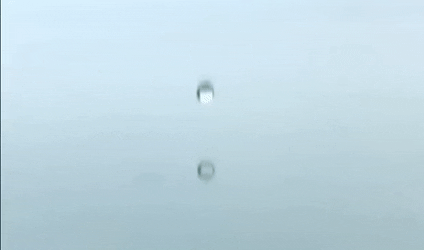Temporal and spatial periodicity
An oscillation itself is a process that is periodic in time. Waves are phenomena where oscillations propagate in space. As such, waves are complex phenomena which show periodicity both in time and in space.
Temporal periodicity
 |
If we pick a single location in space and look at how the relevant quantity — the water level above or below the smooth surface for ripples, the electric or magnetic field for electromagnetic waves — changes over time at that given location, we can observe an oscillation: the relevant quantity is a periodic function of time. We can characterise temporal periodicity with the same quantities as oscillations: period, frequency and angular frequency.
Period
Period is the amount of time it takes for the wave to assume the exact same state at the same location. In the water ripple illustration above, it is the time that passes between observing two successive crests at the location marked with an arrow. The accustomed notation for the period is \(T.\)
Frequency
Frequency is the count of wave cycles in unit time. It can be obtained as the reciprocal of the period:
\[f := \frac{1}{T}.\]
The SI unit of frequency is the hertz:
\[\left[f\right] = 1\,\mathrm{s}^{-1} = 1\,\mathrm{Hz}.\]
Angular frequency
Angular frequency is the frequency multiplied by two times pi:
\[\omega := 2 \pi f.\]
The SI unit of angular frequency is the radian per second:
\[\left[\omega\right] = 1\,\frac{\mathrm{rad}}{\mathrm{s}} \neq 1\,\mathrm{Hz}.\]
Spatial periodicity
If we look at the wave at a given time instant — we make a photograph of it, for instance —, we can see a pattern that repeats itself at equal distances. This behaviour can also be called periodic, but the periodicity is in space and not in time.
Wavelength
The measure of spatial periodicity is called wavelength. Wavelength is the distance between the closest two points in the wave that are exactly in the same state. The distance between two adjacent crests is the same as the distance between two neighbouring troughs, and this distance is equal to the wavelength. Wavelength is most often denoted by the Greek letter lambda: \(\lambda.\)
Wave number
Wave number is the number of cycles in unit distance. It can be obtained as the reciprocal of the wavelength:
\[\tilde{\nu} := \frac{1}{\lambda}.\]
Wave number is the spatial equivalent of frequency.
The SI unit of wave number is the one over metre:
\[\left[\tilde{\nu}\right] = 1\,\mathrm{m}^{-1}.\]
Angular wave number
Angular wave number is the wave number multiplied by two times pi, that is, two times pi over the wavelength:
\[k := \frac{2 \pi}{\lambda} = 2 \pi \tilde{\nu} .\]
The angular wave number is often called simply the wave number.
The SI unit of angular wave number is the radian per metre:
\[\left[k\right] = 1\,\frac{\mathrm{rad}}{\mathrm{m}}.\]